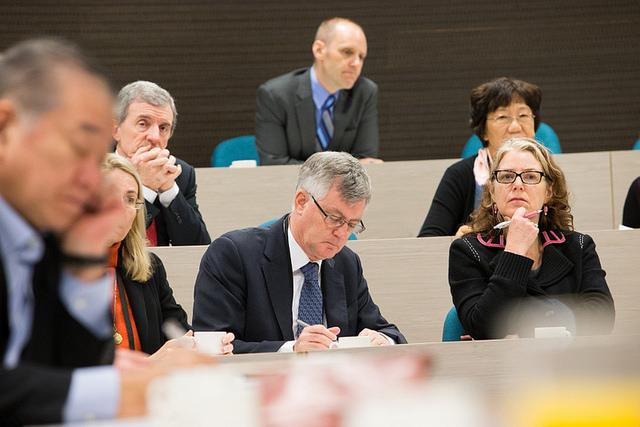Martin Parkinson’s policy dilemmas
Posted By Peter Jennings on January 12, 2016 @ 06:00
Dr Martin Parkinson will soon begin his role as the new Secretary of Prime Minister and Cabinet, succeeding Michael Thawley. Both are highly capable individuals and both have suffered from the lottery of Australian Public Service (APS) changes that follow political leadership coups. One side benefit to Martin Parkinson’s shift from Treasury Secretary in 2015 was that he had the rare chance to think away from the Canberra churn by spending some time at Princeton University’s Griswold Centre for Economic Policy Studies. Through two working papers [2] published in September 2015, we have a chance to see Parkinson’s view of the policy problems facing Australia.
Malcolm Turnbull will set the agenda and tone of Government policy, but it falls to the Secretary of PM&C to mobilise the APS behind that agenda and to provide some discreet steerage to government. There are two key tasks: making the APS machinery work and developing the right policy content. Overall, Parkinson’s assessment is that Australia isn’t well placed to respond to the pace of strategic, demographic, economic and technological change taking place around the world. Australia, he says, suffers from a ‘current bout of complacency’ where ‘our political discourse is failing to provide the public with an explanation of global or national developments, or a roadmap for the future.’
Parkinson offers an important insight when he diagnoses why Australia is in this lacklustre malaise:
‘…very few countries could be said to do “joined–up” government at all well as there is a recurring lack of coordination between the strategic, military and economic institutions across nations. While it may be hard for any country to achieve this outcome, and perhaps harder still for democracies, history suggests that those which do can have a disproportionate influence at key times in history.’
Spot on, Martin! The risks of economists and strategists talking past each other and failing to find a way to engage with each other’s priorities has been at the heart of some serious Australian policy failings in recent years. Let two examples suffice: first, the Asian Century White Paper presented by the Gillard Government in 2012 as the solution to Australia’s long term economic prosperity. All that was needed was to hitch ourselves to the economies of China, Japan, South Korea, Indonesia and India — that and some Little Engine That Could ‘I think I can’ effort [3] would keep the wheels of growth turning for a generation.
The problem was the Asian Century White Paper [4]‘s economically-centred conception of the region’s future. The study could have used a healthy dose of strategic ‘worst-case’ analysis, casting some realist doubt over growth assumptions which, at the start of 2016, look positively naive. Here the challenge is to find a pragmatic path between what many economists continue to see as a ‘glass half full’ future for the Asia–Pacific, where the benefits of growth promoting engagement overcome the problems that strategists worry about: aggressive strategic behaviour in the South China Sea and elsewhere, arms racing, nationalism and deep-seated internal fragility impacting on the behaviour of key regional players.
Another instance of the failure to coordinate Australia’s economic, military and strategic institutions can be seen in the continuing policy snafu that is the 99 year lease of key parts of the Port of Darwin to the Chinese company, Landbridge. It’s evident from recent hearings of the Senate Economics References Committee [5] that Government departments and agencies don’t know even where to begin in assessing the strategic implications of foreign direct investment into critical infrastructure. For all of the furious bureaucratic rear-guard defence of the deal, it left Government scrambling to review legislation on foreign investment to cover loop holes and to explain the lack of consultation with our critical ally and heavy user of the Port, the US.
Why is there such a gap between the world views of Canberra’s economists and strategists? I don’t have a complete answer, but it’s partly because the two groups don’t regularly engage. They largely march to their separate professional beats without the discomfort of struggling to encompass different knowledge domains and understanding different assumptions about how the world works. Moreover there’s a degree of suspicion between the two camps. At worst, economists see strategists as un-quantitative threat-mongers. Strategists return the compliment by concluding that economists are insufficiently ‘real-world’ in their assessment of risk.
The failure to blend a realist economic and strategic world view has resulted in some astonishing gyrations of Australian policy over the last decade. Kevin Rudd’s 2009 Defence White Paper painted a picture of rapidly deteriorating regional security, a burgeoning arms race in East Asia as well as growing political instability. The policy response was to double the size of the submarine fleet and promise to significantly grow other defence capabilities. Quite deliberately to contrast her leadership with Rudd’s, Julia Gillard talked up Asian Century opportunities, declaring an end to the terrorist fears of the ‘9/11’ decade. Tony Abbott, partly from conviction and partly for domestic political effect, emphasised a strong response to the terror threat and re-investing in Defence after Gillard’s spending cuts. Malcolm Turnbull’s positive emphasis on innovation and opportunity changes the language although he faces the same evolving strategic landscape as his three predecessors.
Martin Parkinson has no more important task ahead of him than to stop this see-sawing of strategic language and to create a shared and durable understanding of the risks and opportunities Australia faces in a dramatically changing world. In a later post I’ll set out some suggestions about how to do this by asking what Australia’s regional and global foreign policy settings should be in a post-Asian Century world.
Article printed from The Strategist: https://aspistrategist.ru
URL to article: /martin-parkinsons-policy-dilemmas/
URLs in this post:
[1] Image: https://aspistrategist.ru/wp-content/uploads/2016/01/20504730733_977b67256a_z.jpg
[2] two working papers: https://www.princeton.edu/ceps/publications.shtml
[3] effort: https://www.youtube.com/watch?v=Yx9xO98kcBU&app=desktop
[4] Asian Century White Paper: http://www.defence.gov.au/whitepaper/2013/docs/australia_in_the_asian_century_white_paper.pdf
[5] Senate Economics References Committee: http://www.aph.gov.au/Parliamentary_Business/Committees/Senate/Economics/Foreign_Investment_Review
Click here to print.
